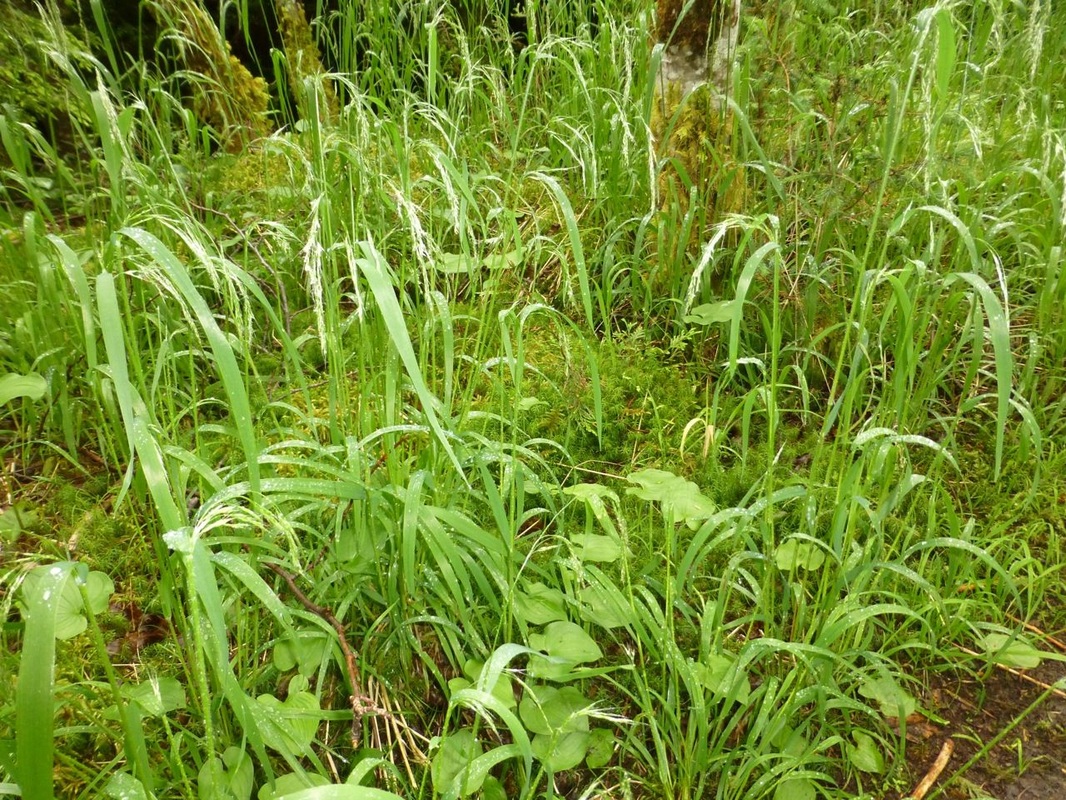Nodding trisetum, nodding false oat • Trisetum cernuum
{Trisetum = some species in the genus have three (treis) awns (seta) on their lemmas; cernuum = nodding}
Identification
This perennial grass grows in tufts with stems 40-120 cm tall. Often the stems are bent at the base. The flat leaves are 5-12 mm wide and hang limply from the stem. The inflorescence takes the form of a loose, open panicle. This nodding, triangular-shaped panicle is 10-30 cm long. Click here for further identification details.
Habitat & Range
Nodding trisetum grows in moist and shaded coniferous forests, the upper portion of beaches, in thickets, and in clearings. It grows from low to middle elevations in western North America. Its coastal range extends from northern California to Alaska.
Similar Species
False melic (Schizachne purpurascens) is similar but uncommon in coastal regions. When lacking an inflorescence nodding trisetum could be confused with nodding wood-reed (Cinna latifolia), which has longer ligules. The leaves and panicles of tall trisetum (Trisetum canescens) are narrower than those of nodding trisetum.
This perennial grass grows in tufts with stems 40-120 cm tall. Often the stems are bent at the base. The flat leaves are 5-12 mm wide and hang limply from the stem. The inflorescence takes the form of a loose, open panicle. This nodding, triangular-shaped panicle is 10-30 cm long. Click here for further identification details.
Habitat & Range
Nodding trisetum grows in moist and shaded coniferous forests, the upper portion of beaches, in thickets, and in clearings. It grows from low to middle elevations in western North America. Its coastal range extends from northern California to Alaska.
Similar Species
False melic (Schizachne purpurascens) is similar but uncommon in coastal regions. When lacking an inflorescence nodding trisetum could be confused with nodding wood-reed (Cinna latifolia), which has longer ligules. The leaves and panicles of tall trisetum (Trisetum canescens) are narrower than those of nodding trisetum.
References
Pojar, J. and MacKinnon, A. (1994). Plants of Coastal British Columbia. Vancouver, BC: Lone Pine Publishing. P. 382.
Smith, J.P., Preston, R.E., and Wilken, D.H. (2013). Trisetum, in Jepson Flora Project (eds.) Jepson eFlora. Accessed 27/10/2014.
Trisetum cernuum Trin. In Klinkenberg, Brian. (Ed.). E-Flora BC: Electronic Atlas of the Plants of British Columbia. Lab for Advanced Spatial Analysis, Department of Geography, University of British Columbia, Vancouver. Accessed 27/10/2014.
Authors and editors of page
Kelly Fretwell, Ian Cruickshank, and Brian Starzomski
Pojar, J. and MacKinnon, A. (1994). Plants of Coastal British Columbia. Vancouver, BC: Lone Pine Publishing. P. 382.
Smith, J.P., Preston, R.E., and Wilken, D.H. (2013). Trisetum, in Jepson Flora Project (eds.) Jepson eFlora. Accessed 27/10/2014.
Trisetum cernuum Trin. In Klinkenberg, Brian. (Ed.). E-Flora BC: Electronic Atlas of the Plants of British Columbia. Lab for Advanced Spatial Analysis, Department of Geography, University of British Columbia, Vancouver. Accessed 27/10/2014.
Authors and editors of page
Kelly Fretwell, Ian Cruickshank, and Brian Starzomski




